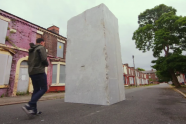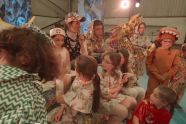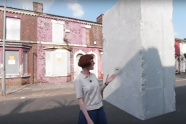Liverpool Biennial Delivers Widespread Impact

Lara Favaretto, Momentary Monument – The Stone, 2016. Installation view at Welsh Streets. Photo: Mark McNulty
Lara Favaretto, Momentary Monument – The Stone, 2016. Installation view at Welsh Streets. Photo: Mark McNulty
An independent report has identified the wide-reaching impact of Liverpool Biennial, assessing the contemporary art festival’s impact on visitors, artists, the city and the arts sector. The report, undertaken by cultural research specialists BOP Consulting, was commissioned to gauge the Biennial’s role across a range of areas, including cultural, social and economic impact.
One of the headline figures is that approximately 1.2 million people had an experience of a Liverpool Biennial 2016 exhibition or public artwork. Hundreds of thousands encountered art around the city, such as Mariana Castillo Deball’s To-day 9th of July 2016 in Liverpool ONE or the Liverpool Fountain of Betty Woodman on The Strand. Three Arriva buses in circulation across the entire city region were designed by artists with local schoolchildren. The moving artworks have brought hundreds of thousands of people into contact with art and the Biennial, demonstrating the benefits of cross-city collaboration.
Included in the overall figure were a total of 109,339 ‘highly engaged’ visitors, who recorded an average of 5.9 visits to different venues and sites. 41% of the visitors came to the Biennial for the first time and the make-up of these visitors was very diverse, with analysis showing that 26% of visitors came from the poorest 20% of neighbourhoods in the country.
Visitor satisfaction was high, as 82% rated the experience good or very good, and 90% believed that Liverpool should be proud of its art scene. Interestingly, 82% stated that Liverpool should do ‘more of this kind of thing’.
Liverpool Biennial’s role in placemaking was highlighted by the fact that 60% of engaged visitors came from outside the city, 63% of whom said they’d be more likely to visit Liverpool again because of their experience during the festival. The economic impact from these visitors was equivalent to supporting 138 full-time jobs in the city.
According to the report, Liverpool Biennial also contributes to the strength of the regional, national and international contemporary art sector through its impact on participating artists and staff. 84% of the artists said that the Biennial allowed them to develop their work, while 92% of the young people who worked as mediators in exhibitions believed that the Biennial had improved their future career prospects.
Download the full Liverpool Biennial 2016 report here and save the date for Liverpool Biennial 2018: 14 July – 28 October.




